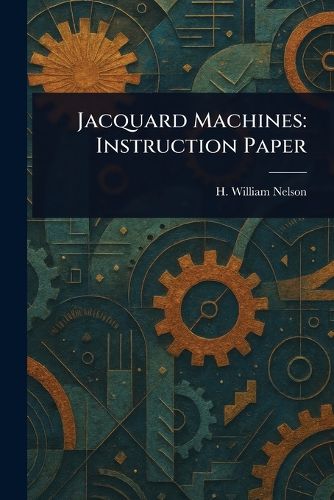Readings Newsletter
Become a Readings Member to make your shopping experience even easier.
Sign in or sign up for free!
You’re not far away from qualifying for FREE standard shipping within Australia
You’ve qualified for FREE standard shipping within Australia
The cart is loading…






This title is printed to order. This book may have been self-published. If so, we cannot guarantee the quality of the content. In the main most books will have gone through the editing process however some may not. We therefore suggest that you be aware of this before ordering this book. If in doubt check either the author or publisher’s details as we are unable to accept any returns unless they are faulty. Please contact us if you have any questions.
Explore the intricate world of automated weaving with "Jacquard Machines: Instruction Paper" by H. William Nelson. This detailed guide delves into the mechanics and operation of the revolutionary Jacquard loom, a cornerstone of textile production and fabric design. Discover the principles behind this groundbreaking invention, which utilized punched cards to automate the weaving of complex patterns.
A vital resource for understanding the history of textile machinery and its impact on industrial arts, this book provides valuable insights into the ingenuity that shaped modern manufacturing. From the fundamental components to the nuances of Jacquard weaving, this instruction paper offers a comprehensive overview suitable for both enthusiasts and those interested in the intersection of technology and craft. Perfect for anyone passionate about fiber arts and the evolution of industrial engineering.
This work has been selected by scholars as being culturally important, and is part of the knowledge base of civilization as we know it.
This work is in the public domain in the United States of America, and possibly other nations. Within the United States, you may freely copy and distribute this work, as no entity (individual or corporate) has a copyright on the body of the work.
Scholars believe, and we concur, that this work is important enough to be preserved, reproduced, and made generally available to the public. We appreciate your support of the preservation process, and thank you for being an important part of keeping this knowledge alive and relevant.
$9.00 standard shipping within Australia
FREE standard shipping within Australia for orders over $100.00
Express & International shipping calculated at checkout
This title is printed to order. This book may have been self-published. If so, we cannot guarantee the quality of the content. In the main most books will have gone through the editing process however some may not. We therefore suggest that you be aware of this before ordering this book. If in doubt check either the author or publisher’s details as we are unable to accept any returns unless they are faulty. Please contact us if you have any questions.
Explore the intricate world of automated weaving with "Jacquard Machines: Instruction Paper" by H. William Nelson. This detailed guide delves into the mechanics and operation of the revolutionary Jacquard loom, a cornerstone of textile production and fabric design. Discover the principles behind this groundbreaking invention, which utilized punched cards to automate the weaving of complex patterns.
A vital resource for understanding the history of textile machinery and its impact on industrial arts, this book provides valuable insights into the ingenuity that shaped modern manufacturing. From the fundamental components to the nuances of Jacquard weaving, this instruction paper offers a comprehensive overview suitable for both enthusiasts and those interested in the intersection of technology and craft. Perfect for anyone passionate about fiber arts and the evolution of industrial engineering.
This work has been selected by scholars as being culturally important, and is part of the knowledge base of civilization as we know it.
This work is in the public domain in the United States of America, and possibly other nations. Within the United States, you may freely copy and distribute this work, as no entity (individual or corporate) has a copyright on the body of the work.
Scholars believe, and we concur, that this work is important enough to be preserved, reproduced, and made generally available to the public. We appreciate your support of the preservation process, and thank you for being an important part of keeping this knowledge alive and relevant.